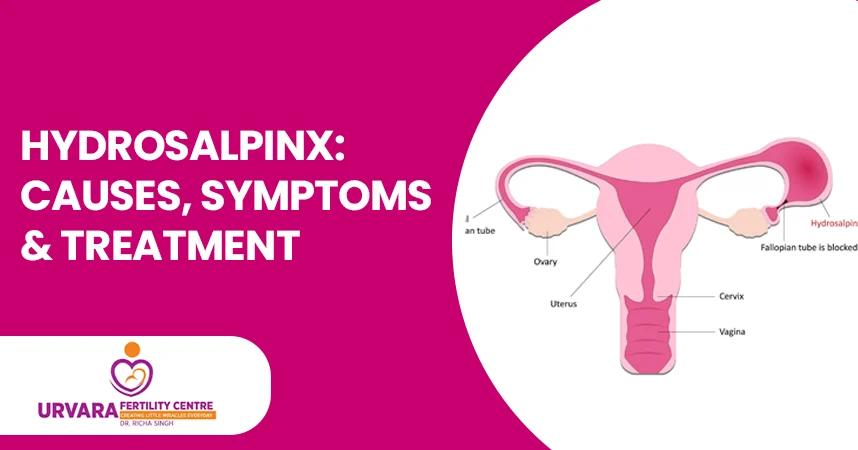
Hydrosalpinx: Causes, Symptoms & Treatment
Do you know? Hydrosalpinx is present in 10% to 20% of infertility cases! You might be thinking what is Hydrosalpinx? This is the condition that affects fallopian tubes causing them to become blocked and filled with a watery fluid. This makes it difficult for a woman to conceive because blockage prevents the egg from moving down the fallopian tube. Here we are going to tell you what are the causes, symptoms, and treatment for Hydrosalpinx.
What are the Causes of Hydrosalpinx?
The most common causes behind hydrosalpinx are related to infections or inflammation within the reproductive system. Let’s explore common causes of hydrosalpinx.
- Pelvic Inflammatory Diseases (PID)
PID is an infection of the female reproductive organs. It most often occurs when sexually transmitted bacteria can spread from your vagina to your uterus, fallopian tubes, or ovaries. It is caused by untreated STIs like gonorrhea. PID is the cause behind hydrosalpinx.
- Tubercular Infection
TB is one of the most prevalent infections in our country and genital tuberculosis is one of the most common causes of tubal blockage or hydrosalpinx.
- Adhesions
Due to adhesion or scar tissues, the blockage may occur in the fallopian tube leading to hydrosalpinx. If you have undergone surgery previously then it can result in adhesions or scar tissue in female reproductive organs.
- Endometriosis
Endometriosis is a painful condition in which tissue that is similar to the inner lining of the uterus grows outside the uterus. It also affects the ovaries, fallopian tubes, and pelvis. When endometrial-like tissue grows outside of your uterus, it can cause scar tissue which is responsible for Hydrosalpinx.
- Long-term use of Intrauterine Devices
Long-term use of IUD may increase the risk of developing hydrosalpinx. Not only this, IUD insertion for a longer period carries a small risk of infection, particularly during the initial period after insertion.
What are the Symptoms of Hydrosalpinx?
Well, many women do not face any symptoms of hydrosalpinx. A hydrosalpinx rarely causes symptoms that why it is difficult for you to identify by yourself about this condition. Whereas, some women may feel pelvic pain after their periods or vaginal discharge this sticky and discolored.
What does Hydrosalpinx cause to our body?
- Increase the chance of ectopic pregnancy.
- Increased chance of tubal block leading to infertility.
How to Diagnose Hydrosalpinx?
To identify the hydrosalpinx condition your infertility doctor in Lucknow may suggest you undergo some procedures. Hydrosalpinx can be diagnosed with the help of these few methods.
A hysterosalpingogram is a type of X-ray through which the uterus and fallopian tube can be analyzed. It is used this X-ray to detect blockages in the fallopian tubes. During this diagnosis, a dye fills your uterine cavity and fallopian tubes. After that dye creates an outline of your uterus and fallopian tubes that stands out on an X-ray. If the X-ray shows the dye flowing through your fallopian tubes, then it means they are open. If the dye meets a barrier that prevents the flow, then it means your fallopian tubes are blocked.
Ultrasound scan and sonohysterosalpingography can help in identifying the Hydrosalpinx condition
Diagnostic Laparoscopy along with chromopertubation is a surgical process in which a surgeon makes a small incision in the abdomen and then inserts a camera which allows them to see the organ details. A dye is pushed inside the uterus to see its spillage from the fallopian tube ends which confirm whether they are patent or blocked. It helps in determining the blockage in the fallopian tubes.
What are the Treatments of Hydrosalpinx?
Accurate treatment of hydrosalpinx can help enhance your chances of a successful pregnancy. Your treatment will depend on a few factors like the severity of the blockage in the fallopian tube: your age or any other severe health condition you are facing. For the treatment, your doctor may suggest you few medications or surgical treatments.
- Salpingectomy
During this process, one or both fallopian tubes are removed. This removal increases your chances of conception as the fluid in hydrosalpinx is toxic to the embryo and removal of tube prevents this.
- Neo salpingostomy
This is a surgical procedure that removes a hydrosalpinx, restoring tubal function. It is usually performed using laparoscopy for terminal blockages at fimbrial end. The surgeon makes a small incision into your fallopian tube, removes the damaged parts of the tube, and reopens the ends that have obstructions.
Understanding the specific causes of your infertility and treating a problem like hydrosalpinx before undergoing embryo transfer IVF can increase your chances of conception. Couples who are trying to conceive and facing hydrosalpinx can undergo the IVF process. With the help of the Best IVF Centre in Lucknow, you can get a personalized treatment plan for a successful pregnancy.
Conclusion
If you are diagnosed with hydrosalpinx then you should not hesitate to consult with your infertility specialist about the treatment. Your infertility specialist can guide you with the right treatment and medications.
Content Created By:

Cyberbizz Technologies
Team - Content Curator

